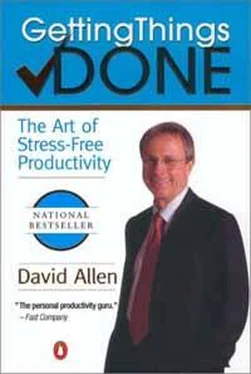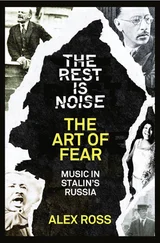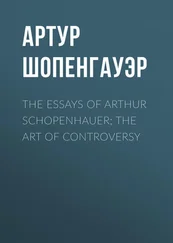THE PURPOSE OF this whole method of workflow management is not to let your brain become lax, but rather to enable it to move toward more elegant and productive activity. In order to earn that freedom, however, your brain must engage on some consistent basis with all your commitments and activities. You must be assured that you're doing what you need to be doing, and that it's OK to be not doing what you're not doing. Reviewing your system on a regular basis and keeping it current and functional are prerequisites for that kind of control.
If you have a list of calls you must make, for example, the minute that list is not totally current with all the calls you need to make, your brain will not trust the system, and it won't get relief from its lower-level mental tasks. It will have to take back the job of remembering, processing, and reminding, which, as you should know by now, it doesn't do very effectively.
All of this means your system cannot be static. In order to support appropriate action choices, it must be kept up to date. And it should trigger consistent and appropriate evaluation of your life and work at several horizons.
There are two major issues that need to be handled at this point:
• What do you look at in all this, and when?
• What do you need to do, and how often, to ensure that all of it works as a consistent system, freeing you to think and manage at a higher level?
A real review process will lead to enhanced and proactive new thinking in key areas of your life and work. Such thinking emerges from both focused concentration and serendipitous brainstorming, which will be triggered and galvanized by a consistent personal review of your inventory of actions and projects.
What to Look At, When
Your personal system and behaviors need to be established in such a way that you can see all the action options you need to see, when you need to see them. This is really just common sense, but few people actually have their processes and their organization honed to the point where they are as functional as they could be. When you have access to a phone and any discretionary time, you ought to at least glance at the list of all the phone calls you need to make, and then either direct yourself to the best one to handle or give yourself permission to feel OK about not bothering with any of them. When you're about to go in for a discussion with your boss or your partner, take a moment to review the outstanding agendas you have with him or her, so you'll know that you're using your time most effectively. When you need to pick up something at the dry cleaner's, first quickly review all the other errands that you might be able to do en route.
A few seconds a day is usually all you need for review, as long as you're looking at the right things at the right time.
People often ask me, "How much time do you spend looking at your system?" My answer is simply. "As much time as I need to to feel comfortable about what I'm doing." In actuality it's an accumulation of two seconds here, three seconds there. What most people don't realize is that my lists are in one sense my office. Just as you might have Post-its and stacks of phone slips at your workstation, so do I on my "Next Actions" lists. Assuming that you've completely collected, processed, and organized your stuff, you'll most likely take only a few brief moments here and there to access your system for day-to-day reminders.
Looking at Your Calendar First
Your most frequent review will probably be of your daily calendar, and your daily tickler folder if you're maintaining one, to see the "hard landscape" and assess what has to get done. You need to know the time-and-space parameters first. Knowing that you have wall-to-wall meetings from 8:00 A.M. through 6:00 P.M., for example, with barely a half-hour break for lunch, will help you make necessary decisions about any other activities.
. . . Then Your Action Lists
After you review all your day-and time-specific commitments and handle whatever you need to about them, your next most frequent area for review will be the lists of all the actions you could possibly do in your current context. If you're in your office, for instance, you'll look at your lists of calls, computer actions, and in-office things to do. This doesn't necessarily mean you will actually be doing anything on those lists; you'll just evaluate them against the flow of other work coming at you to ensure that you make the best choices about what to deal with. You need to feel confident that you're not missing anything critical.
Frankly, if your calendar is trustworthy and your action lists are current, they may be the only things in the system you'll need to refer to more than every couple of days. There have been many days when I didn't need to look at any of my lists, in fact, because it was clear from the front end—my calendar—what I wouldn't be able to do.
The Right Review in the Right Context
You may need to access any one of your lists at any time. When you and your spouse are decompressing at the end of the day, and you want to be sure you'll take care of the "business" the two of you manage together about home and family, you'll want to
look at your accumulated agendas for him or her. On the other hand, if your boss pops in for a face-to-face conversation about current realities and priorities, it will be highly functional for you to have your "Projects" list up to date and your "Agenda" list for him or her right at hand.
Updating Your System
The real trick to ensuring the trustworthiness of the whole organization system lies in regularly refreshing your psyche and your system from a more elevated perspective. That's impossible to do, however, if your lists fall too far behind your reality.
You won't be able to fool yourself about this: if your system is out of date, your brain will be forced to fully engage again at the lower level of remembering.
To make knowledge productive, we will have to learn to see both forest and tree. We will have to learn to connect.
— Peter F.
This is perhaps the biggest challenge of all. Once you've tasted what it's like to have a clear head and feel in control of everything that's going on, can you do what you need to to maintain that as an operational standard? The many years I've spent researching and implementing this methodology with countless people have proved to me that the magic key to the sustainability of the process is the Weekly Review.
The Power of the Weekly Review
If you're like me and most other people, no matter how good your intentions may be, you're going to have the world come at you faster than you can keep up. Many of us seem to have it in our natures consistently to entangle ourselves in more than we have the ability to handle. We book ourselves back to back in meetings all day, go to after-hours events that generate ideas and commitments we need to deal with, and get embroiled in engagements and projects that have the potential to spin our creative intelligence into cosmic orbits.
That whirlwind of activity is precisely what makes the Weekly Review so valuable. It builds in some capturing, revaluation, and reprocessing time to keep you in balance. There is simply no way to do this necessary regrouping while you're trying to get everyday work done.
You will invariably take in more opportunities than your system can process on a daily basis.
The Weekly Review will also sharpen your intuitive focus on your important projects as you deal with the flood of new input and potential distractions coming at you the rest of the week. You're going to have to learn to say no—faster, and to more things—in order to stay afloat and comfortable. Having some dedicated time in which to at least get up to the project level of thinking goes a long way toward making that easier.
Читать дальше











